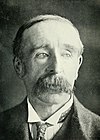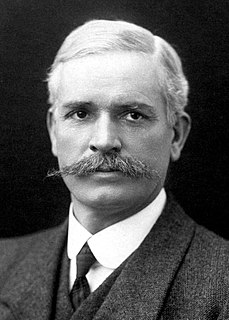
Andrew Fisher was an Australian politician who served three terms as prime minister of Australia – from 1908 to 1909, from 1910 to 1913, and from 1914 to 1915. He was the leader of the Australian Labor Party (ALP) from 1907 to 1915.

Sir Joseph Cook, was an Australian politician who served as the sixth Prime Minister of Australia, in office from 1913 to 1914. He was the leader of the Liberal Party from 1913 to 1917, after earlier serving as the leader of the Anti-Socialist Party from 1908 to 1909.
The Protectionist Party or Liberal Protectionist Party was an Australian political party, formally organised from 1887 until 1909, with policies centred on protectionism. The party advocated protective tariffs, arguing it would allow Australian industry to grow and provide employment. It had its greatest strength in Victoria and in the rural areas of New South Wales. Its most prominent leaders were Sir Edmund Barton and Alfred Deakin, who were the first and second prime ministers of Australia.
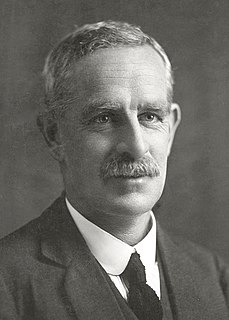
Francis Gwynne Tudor was an Australian politician who served as the leader of the Australian Labor Party from 1916 until his death. He had previously been a government minister under Andrew Fisher and Billy Hughes.
The Liberal Party was a parliamentary party in Australian federal politics between 1909 and 1917. The party was founded under Alfred Deakin's leadership as a merger of the Protectionist Party and Anti-Socialist Party, an event known as the Fusion.

The Third Deakin Ministry was the 7th ministry of the Government of Australia. It was led by the country's 2nd Prime Minister, Alfred Deakin. The Fourth Deakin Ministry succeeded the First Fisher Ministry, which dissolved on 2 June 1909 after the Protectionist Party and the Anti-Socialist Party merged into the Commonwealth Liberal Party "fusion" and withdrew their support in order to form what became the first majority government in federal Australian history. The ministry was replaced by the Second Fisher Ministry on 29 April 1910 following the federal election that took place on 13 April which saw the Labour Party defeat the Commonwealth Liberals.

The Third Fisher Ministry (Labor) was the 10th ministry of the Government of Australia. It was led by the country's 5th Prime Minister, Andrew Fisher. The Third Fisher Ministry succeeded the Cook Ministry, which dissolved on 17 September 1914 following the federal election that took place on 5 September which saw Labor defeat Joseph Cook's Commonwealth Liberals. The ministry was replaced by the First Hughes Ministry on 27 October 1915 following Fisher's retirement from Parliament to become the next High Commissioner to the United Kingdom.

The Second Hughes Ministry was the 12th ministry of the Government of Australia. It was led by the country's 7th Prime Minister, Billy Hughes. The Second Hughes Ministry succeeded the First Hughes Ministry, which dissolved on 14 November 1916 following the split that took place within the governing Labor Party over the issue of conscription. This led to Hughes and his supporters leaving the party to form the National Labor Party, which swiftly received parliamentary support from Joseph Cook and the Commonwealth Liberal Party. The ministry was replaced by the Third Hughes Ministry on 17 February 1917 after National Labor and Commonwealth Liberal merged into the Nationalist Party.

The Scullin Ministry (Labor) was the 19th ministry of the Government of Australia. It was led by the country's 9th Prime Minister, James Scullin. The Scullin Ministry succeeded the Third Bruce Ministry, which dissolved on 22 October 1929 following the federal election that took place on 12 October which saw Labor defeat Stanley Bruce's Nationalist–Country Coalition. The ministry was replaced by the First Lyons Ministry on 6 January 1932 following the federal election that took place in December which saw the United Australia Party defeat Labor. As of 2020, it remains the most recent government to have lost an election after a single term in office.
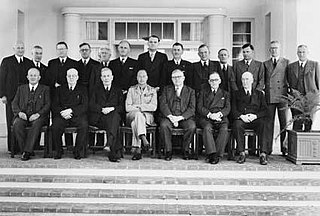
The Second Chifley Ministry (Labor) was the 33rd ministry of the Government of Australia. It was led by the country's 16th Prime Minister, Ben Chifley. The Second Chifley Ministry succeeded the First Chifley Ministry, which dissolved on 1 November 1946 following the federal election that took place in September. The ministry was replaced by the Fourth Menzies Ministry on 19 December 1949 following the federal election that took place on 10 December which saw the Liberal–Country Coalition defeat Labor.

The Fourth Menzies Ministry was the 34th ministry of the Government of Australia. It was led by the country's 12th Prime Minister, Robert Menzies. The Fourth Menzies Ministry succeeded the Second Chifley Ministry, which dissolved on 19 December 1949 following the federal election that took place on 10 December which saw the Coalition defeat Ben Chifley's Labor Party. The ministry was replaced by the Fifth Menzies Ministry on 11 May 1951 following the 1951 federal election.
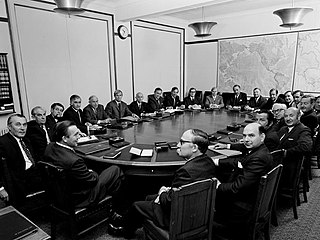
The McMahon Ministry was the 46th ministry of the Government of Australia. It was led by the country's 20th Prime Minister, William McMahon. The McMahon Ministry succeeded the Second Gorton Ministry, which dissolved on 10 March 1971 following the resignation of John Gorton as Prime Minister. The ministry was replaced by the First Whitlam Ministry on 5 December 1972 following the federal election that took place on 2 December which saw Labor defeat the Coalition.
The first Hawke ministry (Labor) was the 54th ministry of the Government of Australia. It was led by the country's 23rd Prime Minister, Bob Hawke. The first Hawke ministry succeeded the Fourth Fraser ministry, which dissolved on 11 March 1983 following the federal election that took place on 5 March which saw Labor defeat Malcolm Fraser's Liberal–National Coalition. The ministry was replaced by the second Hawke ministry on 13 December 1984 following the 1984 federal election.
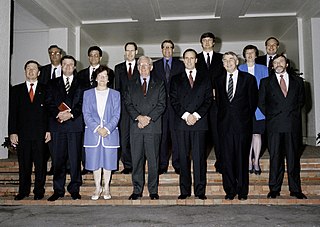
The second Keating ministry (Labor) was the 59th ministry of the Government of Australia. It was led by the country's 24th Prime Minister, Paul Keating. The second Keating ministry succeeded the first Keating ministry, which dissolved on 24 March 1993 following the federal election that took place on 13 March. The ministry was replaced by the first Howard ministry on 11 March 1996 following the federal election that took place on 2 March which saw the Liberal–National Coalition defeat Labor.

The first Howard ministry was the 60th ministry of the Government of Australia. It was led by the country's 25th Prime Minister, John Howard. The first Howard ministry succeeded the second Keating ministry, which dissolved on 11 March 1996 following the federal election that took place on 2 March 1996, which saw the Coalition defeat Paul Keating's Labor Party. The ministry was replaced by the second Howard ministry on 21 October 1998 following the 1998 federal election.

The fourth Howard ministry was the 63rd ministry of the Government of Australia. It was led by the country's 25th Prime Minister, John Howard. The fourth Howard ministry succeeded the third Howard ministry, which dissolved on 22 October 2004 following the federal election that took place on 9 October. The ministry was replaced by the first Rudd ministry on 3 December 2007 following the federal election that took place on 24 November which saw Labor defeat the Coalition.
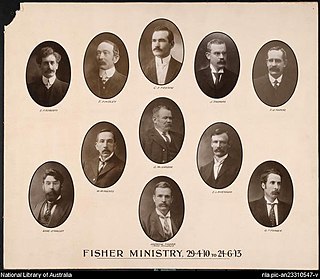
The Second Fisher Ministry was the 8th ministry of the Government of Australia. It was led by the country's 5th Prime Minister, Andrew Fisher. The Second Fisher Ministry succeeded the Third Deakin Ministry, which dissolved on 29 April 1910 following the federal election that took place on 13 April which saw Labor defeat the Alfred Deakin's Commonwealth Liberal Party. It is the first federal government in Australian history to be elected with a majority in the House of Representatives, as well as the first majority national Labor government in the world. The ministry was replaced by the Cook Ministry on 24 June 1913 following the federal election that took place in May which saw the Liberals defeat Labor.

The 1917 Australian federal election was held in Australia on 5 May 1917. All 75 seats in the House of Representatives and 18 of the 36 seats in the Senate were up for election. The incumbent Nationalist Party, led by Prime Minister Billy Hughes, defeated the opposition Labor Party led by Frank Tudor in a landslide.

The 1914 Australian federal election was held in Australia on 5 September 1914. The election had been called before the declaration of war in August 1914. All 75 seats in the House of Representatives and all 36 seats in the Senate were up for election, as a result of the first double dissolution being granted. The incumbent Commonwealth Liberal Party, led by Prime Minister Joseph Cook, was defeated by the opposition Labor Party under Andrew Fisher. Fisher returned for a third term as prime minister.

The 1913 Australian federal election was held in Australia on 31 May 1913. All 75 seats in the House of Representatives, and 18 of the 36 seats in the Senate were up for election. The incumbent Labor Party, led by Prime Minister Andrew Fisher, was defeated by the opposition Commonwealth Liberal Party under Joseph Cook. The new government had a majority of just a single seat, and held a minority of seats in the Senate. It would last only 15 months, suffering defeat at the 1914 election.




